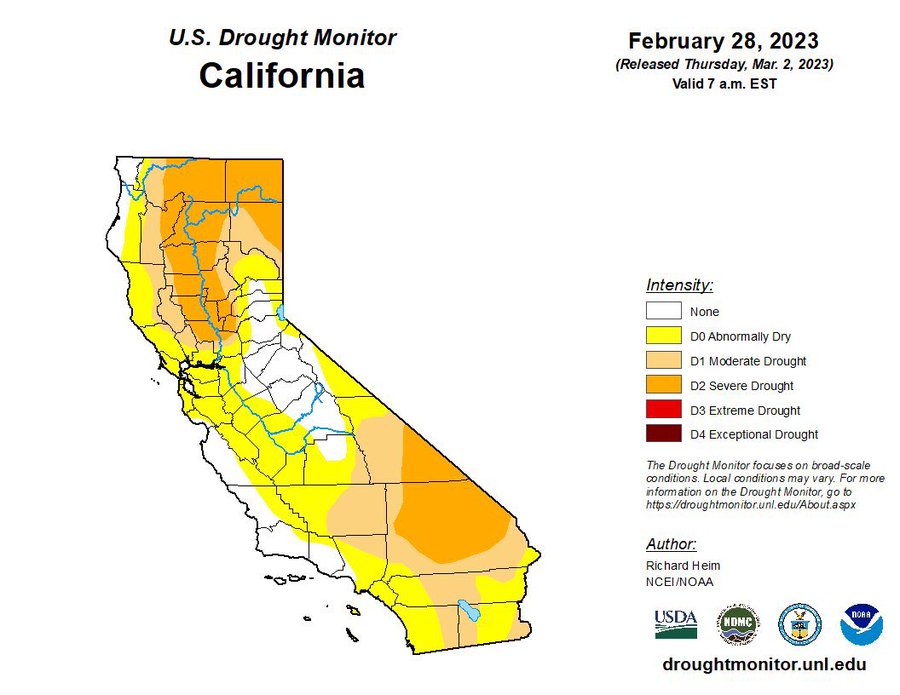Yahoo! News
Warm atmospheric rivers in California forecast could spell trouble for massive snowpack
The risk of flooding could rise dramatically with the arrival of warm rains later this month.
David Knowles, Senior Editor – March 2, 2023
Californians are bracing for the arrival of more atmospheric rivers over the coming weeks that could dump rain on the state’s massive snowpack and dramatically increase the risk of flooding.
“I would suggest that literally anyone who lives in the flood plains of these rivers, which is millions of people, pay attention to what’s going on and be prepared for floods,” Peter Gleick, climate scientist and founder of the Pacific Institute, told Yahoo News.
With snowpack levels already near all-time highs, cold temperatures in the state have begun moderating in recent days, and there is a roughly 20% chance of warmer atmospheric river rains later this month.
“The really big worry for flooding when you have a lot of snow in the mountains, your reservoirs are relatively full and you get a really warm, massive storm that dumps a lot of rain and melts a lot of snow, is that you overwhelm the reservoirs,” Gleick said.
On the bright side, this year’s rain and snow amounts have helped erase or ease California’s long-term drought crisis.

But the impressive snowpack coupled with warmer air and rain poses other risks.
“This is a good pattern for drought relief,” UCLA climate scientist Daniel Swain told Yahoo News about the rain and snowpack. “We’ve got to think about what happens when that all comes downstream in the late spring and early summer. There’s almost guaranteed to be at least minor snowmelt flooding this year. The question is whether we’re lucky and it’s nice and gradual and it doesn’t cause any big problems. Do we get some huge early season heat waves? That would be big uh-oh.”
Swain and Gleick both stress that human beings are not good at predicting weather more than a few days in advance. But the arrival of one or more warm atmospheric rivers in California over the coming weeks could be bad news for those living downstream from the snowpack.
“There’s no way to know. It depends on where that storm comes,” Gleick said. “Probably the most vulnerable area, generically speaking, is Sacramento on the American River. The main reservoir that protects Sacramento from flooding is Folsom, which is on the American River. Folsom, I think everyone would acknowledge, is undersized for the level of protection that Sacramento really needs.”
So far this year, in terms of historical averages for March 2, Folsom is at 114% of average capacity, a little more than half-full overall. But multiple additional atmospheric river rain events could be problematic.
“We have the classic dilemma in California, which is that we want to keep our reservoirs relatively empty in the winter for flood protection, and we want them as full as possible at the end of the rainy season in April,” Gleick said. “The biggest demand for water is during the dry season, April through September, the growing season. So reservoir operators have to balance those two things. They don’t want to fill the reservoirs too soon if there’s a risk of flooding, and it’s bad if they don’t capture as much water as they can for the dry part of the year.”
While Republicans like House Speaker Kevin McCarthy of California often criticizes Democratic Gov. Gavin Newsom for not diverting runoff water during the rainy season into reservoirs, Gleick explained that reservoir managers have a difficult task this year due to the above-average rain and snowfall.
“They look at how much water is in the mountains stored as snow and they look at what’s in the reservoirs. They have models that tell them, Well, you can add this much water, you can let this much out. That’s the way they operate the system,” Gleick said. “The problem of course is that historical data are just averages, they’re not perfect and you can be surprised. The other problem, of course, is that climate change is telling us that all of the historical data are no longer a guide to the future.”
For now, the Sierra Nevada continued to receive multiple feet of snow this week.
“If we were to get heavy rain with a warm system and a lot of tropical moisture feeding into it, that would melt all of the snow that just fell in the mountains,” David Sweet, a meteorologist with the National Weather Service in Oxnard, told the Los Angeles Times, adding, “We need to stick that in the back of our mind and think, ‘Boy, I sure hope that doesn’t happen.’”
